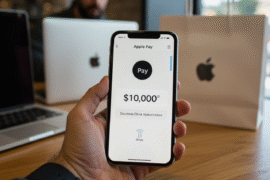This article may contain references to products or services from one or more of our advertisers or partners. We may receive compensation when you click on links to those products or services. Nonetheless, our opinions are our own.

Updated by Albert Fang
- Key Highlights
- Introduction
- Understanding Interest Saving Balance
- Preparing to Utilize an Interest Saving Balance
- Step-by-Step Guide to Managing Your Interest Saving Balance
- Maximizing Your Interest Savings
- Conclusion
-
Frequently Asked Questions
- What Is the Difference Between Interest Saving Balance and Regular Savings?
- How Often Should I Check My Interest Saving Balance?
- Can I Lose Money in an Interest Saving Account?
- How Do Interest Rates Affect My Interest Saving Balance?
- What Are the Best Practices for Managing an Interest Saving Balance?
- Recommended Reads
Key Highlights
- The interest saving balance is the least you need to pay on a credit card. It adds any new purchases made in that billing time.
- Paying this balance can help you avoid more interest charges.
- It is important to understand interest rates and APY to boost your saving chances.
- Having clear money goals will help your saving plans.
- Keeping an eye on your savings and changing your plan when needed will improve your saving results.
Introduction
In personal finance, knowing about interest rates is crucial. They greatly impact your savings. Many people often go for regular savings accounts. However, it’s smart to explore other ways to grow your money. A key concept is the interest saving balance. This idea can assist you in managing your credit card payments. It can also help improve your overall financial well-being. Let’s find out more about interest saving balances. They can help you make better choices with your money.
Understanding Interest Saving Balance
An interest saving balance is the amount a credit cardholder can choose to pay on their balance each month. This amount includes the minimum payment due and any new purchases made in the most recent billing cycle.
Paying the interest saving balance won’t get rid of your credit card debt. However, it can help you avoid adding more interest to what you already owe. Just remember, using this method may actually lead to you paying interest for a longer time than if you paid off the full statement balance. An interest-saving balance refers to the amount you need to pay—usually the statement balance plus any installment plan portion—to avoid incurring interest on new purchases.It’s a smart way to manage credit card payments by covering what will cost interest while letting longer-term installments carry forward.
Also, if you’re curious about checking whether content is AI-generated, you might want to try this tool: Ai Content Detector.
The Basics of Interest Saving Balance
To understand how an interest saving balance works, we need to look at its key parts. First, you find it by adding the minimum payment from your credit card to the total of new charges from your last bill.
When you pay off this balance, it helps keep your total credit card debt from increasing compared to last month. However, be careful because interest will still add up on any balance you have left.
It’s important to understand the annual percentage yield (APY) on your credit card. The APY is the interest rate you pay each year on your balance. This rate can really change how much it costs to carry a balance on your credit card. For a clearer view of how different APY levels affect your potential savings or cost over time, consider trying a profit calculator. It can help you quickly estimate outcomes based on various interest rates and payment strategies.
Recommended: Photography Invoice Receipt Template
How Interest Saving Balances Differ From Regular Savings
An interest saving balance is different from a traditional savings account. In a traditional savings account, you earn interest on the money you put in. However, with an interest saving balance, the aim is to lower the interest you owe. Both methods deal with managing money, but they have different purposes.
An interest saving balance can help you deal with credit card debt. Its purpose is to reduce interest charges. On the other hand, savings accounts, like relationship savings accounts and money market accounts, are designed to help you grow your wealth by earning interest over time.
It is important to make good choices about both types. This can help you maintain a solid financial portfolio.
Preparing to Utilize an Interest Saving Balance
Before using an interest-saving balance, you need to prepare. First, look closely at your credit card statements. Make sure to check the minimum payment due. Also, note the interest rate and the APY.
Next, look at your current money situation. Set clear goals for yourself. This will help you see if using an interest saving balance works for your overall money plan.
What You Need Before Getting Started
Before you take care of your finances, like interest saving balance, you need to check if your devices meet the right system requirements and security policies. Make sure the bank’s website or app works with your browser version for a smooth experience.
If you enjoy mobile banking, you should download the bank’s app on your iPhone or Android device. A stable internet connection is important to prevent any interruptions.
Finally, make sure you meet the requirements for special features or offers about interest saving balances. If you have questions about your account needs, contact your bank directly.
Setting Up Your Financial Goals
Having clear financial goals is very important if you want to add an interest saving balance to your savings plan. While managing your savings and interest-saving balance, you may also consider diversifying your financial strategy by consulting with top-rated gold IRA custodians, who can help you secure your wealth through gold investments. First, think about your short-term and long-term goals. Do you want to pay off debt? Or do you want to build an emergency fund or save for a down payment?
After setting your goals, you need a plan to achieve them. Consider your income, expenses, and any debt you have.
Using an interest saving balance can help you save money on interest charges. This will support you as you work toward your financial goals.
Step-by-Step Guide to Managing Your Interest Saving Balance
Managing your interest saving balance can be easy. You just need to follow these simple steps to include this strategy in your financial routine.
This guide will help you understand the process. You will find clear instructions and helpful tips. Let’s get started!
Step 1: Opening an Interest Saving Account
If your bank can’t give you what you want, try looking for a different one that can. For example, if you are considering using Chase, visit their website or call customer service. Ask them about their interest saving balance options.
- Please read the terms and conditions.
- Look closely at the fees, minimum balance requirements, and interest rates before making your choice.
It is important to choose the right bank and account. This choice will help you make the most of your interest saving balance.
Step 2: Allocating Funds to Maximize Savings
Once you open a savings account, the next thing to do is make a plan for your money. This will help your savings grow. Think about these points:
- Minimum Balance: Always maintain the minimum balance in your account. This will help you skip monthly fees.
- Annual Percentage Yield (APY): Aim for the best APY you can find. Search for accounts with higher interest rates.
- Regular Deposits: Deposit money regularly. This will help you achieve your savings goals faster.
If you pay attention to these key factors, you can manage your interest saving balance better. This way, you will notice your savings grow over time.
Step 3: Monitoring and Adjusting Your Savings Strategy
Once you have your interest saving balance ready, don’t ignore it. Make checking it a part of your regular money routine. Look at how your savings are doing often. See where you can improve things.
Are your savings growing as you want? Are you meeting your savings goals? If not, it may be time to change your savings plan based on what you find.
- This might mean adding more money.
- It could involve finding options that earn higher interest.
- You may also need to change your budget to save more money.
Maximizing Your Interest Savings
Now that you know the basics of interest saving balances and how to use them, let’s go over some tips. These tips can help you earn more interest.
By being active and saving smartly, you can grow your money more.
Tips for Earning More Interest on Your Savings
- Save more money regularly.
- Look for high-interest savings accounts.
- Keep your money in accounts for a longer time.
- Avoid withdrawing money often.
- Consider investing in safe bonds.
- Use savings apps that offer good rates.
- Check fees that can lower your interest.
- Stay informed about new savings options.
- Get the Best APY: Look for savings accounts with high APYs. This helps you earn more interest on your money.
- Make Transfers Automatic: Set up automatic transfers from your checking account to your savings account. This makes saving easier.
- Use Promotional Rates: Watch for special offers and promotional interest rates that banks provide.
Making even little changes in how you save money can lead to big improvements as time goes on.
Common Mistakes to Avoid With Interest Saving Balances
Managing your interest savings balance can be simple. However, there are some errors you need to avoid. First, make sure you keep the minimum balance needed in your savings account. If you don’t, you could face extra fees. These fees can lower your interest earnings.
Second, keep an eye on the new purchases you make with your credit card. These transactions increase your balance. They also impact the interest you earn.
By avoiding these common mistakes, you can improve your interest savings balance. This will help you stay on track to reach your financial goals.
Conclusion
In conclusion, learning how to use an interest saving balance can really improve your money situation. It’s key to understand how it is different from regular savings. Set clear goals and monitor your savings. This will help you get the most out of it. Ensure you open the right account and invest your money wisely. Keep adjusting your plan to achieve the best results. To earn more interest and avoid common errors, stay active and informed about your interest saving balance. By following good tips, you can create a stronger financial future. If you want to make the most of your savings, use this guide and take control of your money today.
Frequently Asked Questions
What Is the Difference Between Interest Saving Balance and Regular Savings?
The main difference is what they do. An interest saving balance helps you pay less interest on your debts, especially from credit cards. Regular savings accounts, including traditional savings accounts, relationship savings accounts, and money market accounts, are for making money by earning interest.
How Often Should I Check My Interest Saving Balance?
To handle your money properly, it’s important to look at your interest saving balance and your bank account statements at least once a month. Doing this helps you see your current balance, any interest charges, and possible fees.
Can I Lose Money in an Interest Saving Account?
Interest-saving accounts are often considered safe choices. If your bank has good security policies and you maintain the minimum balance required, the risk of losing your money is quite small.
How Do Interest Rates Affect My Interest Saving Balance?
Interest rates directly affect your interest saving balance. When interest rates go up, you will pay more in interest charges on your balance. But when interest rates go down, you will pay less in interest.
What Are the Best Practices for Managing an Interest Saving Balance?
To make the most of your interest saving balance, check your account often. Always make regular payments that are more than the minimum. Avoid making new purchases that could increase your balance. Find ways to raise your income. Consider placing your money in higher-yield savings options to earn more interest saving.

Reviewed and edited by Albert Fang.
See a typo or want to suggest an edit/revision to the content? Use the contact us form to provide feedback.
At FangWallet, we value editorial integrity and open collaboration in curating quality content for readers to enjoy. Much appreciated for the assist.
Did you like our article and find it insightful? We encourage sharing the article link with family and friends to benefit as well - better yet, sharing on social media. Thank you for the support! 🍉
Article Title: What Is an Interest Saving Balance and How Does It Work?
https://fangwallet.com/2024/11/14/what-is-an-interest-saving-balance/The FangWallet Promise
FangWallet is an editorially independent resource - founded on breaking down challenging financial concepts for anyone to understand since 2014. While we adhere to editorial integrity, note that this post may contain references to products from our partners.
The FangWallet promise is always to have your best interest in mind and be transparent and honest about the financial picture.
Become an Insider

Subscribe to get a free daily budget planner printable to help get your money on track!
Make passive money the right way. No spam.
Editorial Disclaimer: The editorial content on this page is not provided by any of the companies mentioned. The opinions expressed here are the author's alone.
The content of this website is for informational purposes only and does not represent investment advice, or an offer or solicitation to buy or sell any security, investment, or product. Investors are encouraged to do their own due diligence, and, if necessary, consult professional advising before making any investment decisions. Investing involves a high degree of risk, and financial losses may occur including the potential loss of principal.
Source Citation References:
+ Inspo
There are no additional citations or references to note for this article at this time.












































